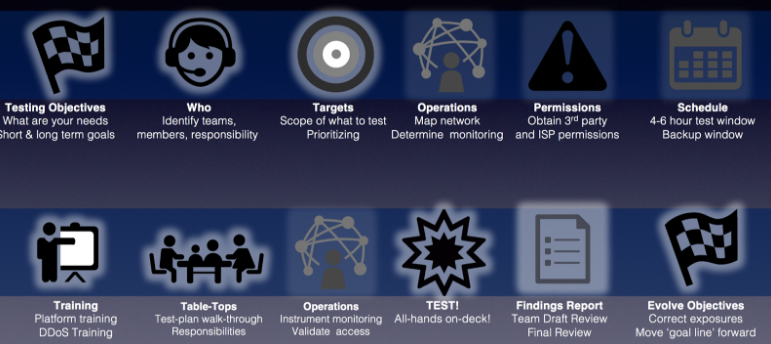September 13, 2017
At a high level, how is DDoS testing conducted?

1. SCOPING:Identifying what needs to be protected, what will be tested first, building a control matrix of alerting and defensive countermeasures and lines of responsibility. All 3rd party systems will be identified. This information is captured in a template spreadsheet called the ‘Test Plan Template’. As this sheet is filled out all details for the test will be contained in it. Copies of this spreadsheet can be distributed to participants.
2. DESIGN:Targets (domain names, URL’s, IP addresses) will be analyzed from an ‘attacker’ perspective and a profile will be created for each target. Potentially, this will uncover new potential attack variations that can be considered. Following the profiling a test plan will be created to fit within the given test windows. Each ‘test’ will take approximately 20 minutes with a 5 minute cool-down. The first few tests will be longer and later tests will be shorter. Approximately 2 tests can be run per hour. Creating the initial test plan will require some back/forth via secure email with your teams. The test plan is distributed in an XLS template that contains all the information for every party joining the test.
3. TEST IMPLEMENTATION: The tests will be created in the testing platform portal. These tests become part of your personalized test library and can be re-run in the future. You will have access to be able to inspect / review / clone / modify the tests.
4. PRE-TEST CHECKS: Every parameter for the test will be input and can be tested at very low levels (e.g. 1 request/sec) to ensure all the headers/cookies/randomization/etc… parameters are set properly.
5. TEST-WINDOW EXECUTION: Testing can be done 24/7. Two test staff will be on the bridge during test-day: one to manage the traffic / tests, and one to investigate, analyze and note outcomes/recommendations. A time-stamped log of these observations is included for every test vector and is extremely useful in reconstructing exactly what occurred during a test. During the test:
• OPS will take notes using platform portal.
• Traffic will only start when client agrees
• Client can stop traffic at any time
• Ramp-ups/down will only be done if agreed to by client
• Order of tests can be changed by request
• Monitors will show any outages / impact during test. Any such will also be announced on the bridge.
6. POST-TEST SELF-SERVE-ACCESS: Users can log in to the platform control portal, load any defined test or create new tests. This is excellent for post-test remediation and validating configuration changes before/after a more formal test. The platform provides 24/7 ability to log in and run tests yourself, at any level (big/small). There are always 10 ‘shared’ agents available and more can be added (virtually unlimited) by separate order/ticket. Training for 4 people is included.
